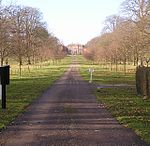Walford, Ross-on-Wye

Walford is a village and civil parish in south Herefordshire, England, two miles south of the market town of Ross-on-Wye. It includes the settlements of Bishopswood, Coughton, Deep Dean, Hom Green and Walford. The two Church of England churches in the parish, All Saints at Bishopswood and St Michael & All Angels at Walford, lie in different benefices. The centre of the nave of Walford church was constructed around 1100 making it one of the earliest churches to be built in Herefordshire. Bishopswood Church is far more recent being endowed in 1841.The B4324 Ross-on-Wye to Coleford road runs through the village. The River Wye forms the western boundary of the parish. Kerne Bridge allows the B4229 road to cross the river to Goodrich. Walford Court was the headquarters of Col John Birch during the siege of Goodrich Castle in the English Civil War. In Hom Green is Hill Court Manor, a country house built in 1700, now a Grade I listed building and the closed Church of the Paraclete. The Grade II listed church was built in 1905–06 to designs by George Frederick Bodley in memory of Major Lionel James Trafford.Walford is sometimes confused with another Walford in the north of the county. Walford has a village hall and a primary school.
Excerpt from the Wikipedia article Walford, Ross-on-Wye (License: CC BY-SA 3.0, Authors, Images).Walford, Ross-on-Wye
Archenfield Road,
Geographical coordinates (GPS) Address Nearby Places Show on map
Geographical coordinates (GPS)
| Latitude | Longitude |
|---|---|
| N 51.8806 ° | E -2.6014 ° |
Address
Archenfield Road
HR9 7TF
England, United Kingdom
Open on Google Maps








